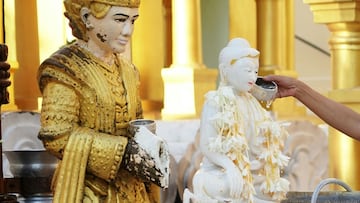Where is Mandalay, Myanmar’s earthquake-stricken city, and what cultural treasures does it hold?
Friday morning saw Myanmar hit by a 7.7 earthquake, with buildings and other structures turned to rubble after collapsing.


Mandalay, Myanmar’s second-largest city, sits on the eastern bank of the Irrawaddy River, around 400 miles north of Yangon. With a population of roughly 1.2 million, it’s a place of deep religious significance and crumbling colonial architecture – now jolted into global headlines by a powerful 7.7-magnitude earthquake that struck Friday morning.
According to the US Geological Survey, the quake’s epicenter was just over 10 miles beneath the surface and alarmingly close, only 10.7 miles from Mandalay itself. That shallow depth made it especially brutal for those on the ground.
Just experienced a 7.7 strength #earthquake in #Bangkok for close to 3 minutes. Its epicenter was Mandalay, Myanmar, over 1200 kms from here.
— Joseph Çiprut (@mindthrust) March 28, 2025
Despite the distance it swayed buildings; caused cracks, forced evacuations and rooftop pools cascaded much water to down below. Scary! pic.twitter.com/iIeV7WQWN6
Tremors sent people running into the streets in panic. Some were still in bathrobes. Others were seen dripping wet, fresh from rooftop pools, after being shaken out of their morning routines in faraway Bangkok – over 500 miles away. The initial quake was followed by a strong aftershock, rattling nerves across Myanmar, Thailand, and China’s Yunnan Province. Though there were no confirmed casualties at the time of writing, Myanmar’s fire services were already combing through buildings in Yangon and beyond, with videos online showing possible damage and blocked roads in Mandalay. Some skyscrapers under construction in Bangkok didn’t hold up. One widely circulated collapsed entirely as workers fled.
My god—Earthquake (a Richter ~7.7) causes a skyscraper to collapse in Bangkok. Hope all the construction workers made it out. pic.twitter.com/2ZAGnMh2u5
— Eric Feigl-Ding (@DrEricDing) March 28, 2025
What is Mandalay known for?
While its name might conjure up faded colonial novels or Kipling’s old poem, Mandalay is a living city with a loaded past. Built in 1857 by King Mindon as the final royal capital of Burma, it was always intended to be the beating heart of Buddhist learning. Even today, it has one of the highest concentrations of monks in Southeast Asia.
Kuthodaw Pagoda, Mandalay pic.twitter.com/MH8kX30Ch5
— Akanisi (@AkanisiRadu) March 13, 2025
Landmarks like Mandalay Hill, the sacred Mahamuni Buddha Temple, and the Kuthodaw Pagoda, home to the so-called “world’s largest book,” all speak to its religious and cultural weight. Each one now faces fresh risk. The quake may have cracked foundations, shifted monuments, and damaged artworks passed down for generations. Not all of this will be immediately obvious – but it matters.
⚡️Aftermath Of The Mahamuni Pagoda In Mandalay Following The M7.7 Earthquake. #earthquake #Bangkok #Tragedy #StayStrong #earthquake #แผ่นดินไหว #Bangladesh #Myanmar #Thailand pic.twitter.com/lF9SkC2X8E
— THE SQUADRON (@THE_SQUADR0N) March 28, 2025
This city has already lost once: during World War II, Allied bombing leveled much of the old Royal Palace. What stands now is a reconstructed version. That’s why people here don’t just fear for their safety, they fear for their cultural memory.
Photo shows the aftermath of the Mahamuni Pagoda in Mandalay, Myanmar from powerful earthquake. pic.twitter.com/7hpKMkJQm7
— AZ Intel (@AZ_Intel_) March 28, 2025
Related stories
Get your game on! Whether you’re into NFL touchdowns, NBA buzzer-beaters, world-class soccer goals, or MLB home runs, our app has it all.
Dive into live coverage, expert insights, breaking news, exclusive videos, and more – plus, stay updated on the latest in current affairs and entertainment. Download now for all-access coverage, right at your fingertips – anytime, anywhere.
Complete your personal details to comment